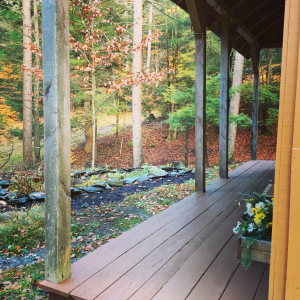The cabin on Turnip Hill Road that I bought when I moved back home-ish to the Adirondacks was one room. Two hundred and fifty square feet, which, spelled out like that, looked bigger than 250. (Never Coming Back, p. 10)
 Fifteen years ago, you signed a series of legal documents faxed to your home in Minneapolis. The legal documents meant that a patch of land in Vermont was now yours. Despite the fact that you knew this particular part of Vermont well, you hadn’t ever seen this particular hill in real life.
Fifteen years ago, you signed a series of legal documents faxed to your home in Minneapolis. The legal documents meant that a patch of land in Vermont was now yours. Despite the fact that you knew this particular part of Vermont well, you hadn’t ever seen this particular hill in real life.
You went to walk the land only after it was yours, driving down the dirt roads that are 70% of all Vermont roads, searching for the unmarked entrance to the rudimentary driveway. What had you gotten yourself into? You lived in Minneapolis, for God’s sake. Yes, you’d always wanted to live in Vermont, but still, you lived in Minneapolis. Were you nuts? Maybe, but you went ahead anyway.
Once there, you couldn’t believe how beautiful it was. Those giant trees. That one white pine, my God, you had never seen a white pine so tall, so huge. From the very top of the land you looked east, to New Hampshire, and there was Mt. Monadnock.
A year later, you and your friends put together a tiny one-room cabin from a kit bought off eBay. Another friend cut down some of the little evergreens that were overtaking the slope. Someone else drilled a well, and someone else spread gravel on the driveway. Now there’s a firepit lined with rocks and benches made from boards nailed to stumps. A hammock now hangs from straps encircling two white pines. A clothesline stretches between two trees. There’s a new outhouse, built in a single day by a young woman with muscles and know-how.
Once, the cabin did not exist. It was a dream in the mind of a young woman who had always wanted to live in Vermont. It doesn’t make sense to buy a patch of forest you’ve never seen, you told yourself. It doesn’t make sense to build a one-room cabin in Vermont when you live in Minneapolis. But you went ahead anyway.
From something that was not real and that didn’t exist came something real. Something you can touch. The top of a tall hill, from which you can see a far horizon. A narrow porch looking out over the low mountains of southern Vermont, trees turning to flame in autumn. And so it goes. Things don’t make sense, but we do them anyway. What exists at first only in someone’s heart turns, over years, into something real.
* * *
 Never Coming Back, my new novel, wrote itself in a compulsive rush. Questions tumbled out across the pages, fierce questions that I have spent my own life asking myself. Why do we so often hide so much from the people closest to us? Why, much of the time, do we assume that there will always be more time? Why, for so many of us, is it only at the end of life that we spill our secrets, desperately seeking to close the distance between ourselves and the people we most love?
Never Coming Back, my new novel, wrote itself in a compulsive rush. Questions tumbled out across the pages, fierce questions that I have spent my own life asking myself. Why do we so often hide so much from the people closest to us? Why, much of the time, do we assume that there will always be more time? Why, for so many of us, is it only at the end of life that we spill our secrets, desperately seeking to close the distance between ourselves and the people we most love?
How well can we ever really know one another?
Faulkner’s famous, ferocious question was one of the guiding lights behind Never Coming Back, a book about the relationship between two people –Tamar Winter and her daughter Clara– who, despite their profound love for each other, have never been able to talk about the secrets they hold in their hearts. But now Tamar has early-onset Alzheimer’s, and time is running out. Tamar and Clara struggle and stumble toward reconciliation, resolution, and clarity. They try, and try, and try again. Like most of us.
Share this:





